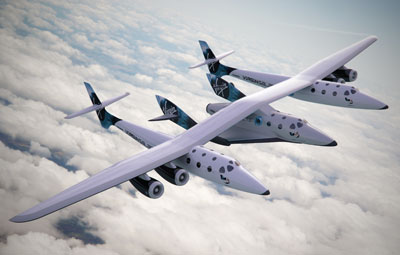Virgin Galactic: marketing for the Earth?by Taylor Dinerman
|
| The design of SpaceShipTwo is a logical step forward from the purely experimental X Prize class SpaceShipOne to the new craft whose goal is to carry paying customers. |
More than a hundred passengers have already signed up as “Founders” for the suborbital flight. Many of them have already gone through centrifuge rides at the NASTAR facility in Philadelphia, with few ill effects. Branson and Rutan are confident that the g-forces involved, 3.5g on the way up and 6g for a short time on the way down, can be endured by anyone in moderately good health. They are confident that this will open the way for ordinary people to handle the greater stress loads faced by those who fly into orbit.
It will be a long while before SpaceShipTwo is fully operational. The plan is to rool out the first one, and the first White Knight Two, sometime this summer. Due to the accident that killed three of Rutan’s employees in July of last year, much of the work on the propulsion system has been frozen. They still have no clear idea what happened and are wisely holding back until they do. Under these circumstances Virgin Galactic will be lucky to fly its first paying passengers before the end of 2011.
This also means that plans for SpaceShipThree—an orbital successor to SpaceShipTwo—is probably also on hold and will not be more than a minor part of Scaled Composites workload for at least a couple of years. This is to be regretted since designing a craft that can reach orbit and return safely will take all of Burt Rutan’s indisputable genius as well as the full time efforts of his team. As his main competitors in the field, Elon Musk’s SpaceX and Jeff Bezos’s Blue Origin, know, getting to orbit is extremely difficult.
Branson knows this, even if he tends to minimize it in his sales pitches. And in spite of his fashionable environmentalist rhetoric—and being fashionable is what the Virgin Group is all about—he does seem to understand that humanity’s future depends to a large extent on being able to get at and exploit the resources of the solar system. Mining the Moon to build solar power satellites is probably not something that most environmentalists will look kindly on.
This balancing act would be amusing if it was merely a question of executing a successful business plan. On the one hand, he has to satisfy the green lobby in all its many shapes and forms, and on the other he does have a real enthusiasm for new technology and for its potential to accomplish such goals as ending or drastically reducing child poverty on this planet. So he has to carefully repeat, over and over again, the latest green mantras about global warming, while at the same time promoting new technologies that will, if they are successful, draw down the wrath of the environmentalists.
| In spite of his fashionable environmentalist rhetoric—and being fashionable is what the Virgin Group is all about—Branson does seem to understand that humanity’s future depends to a large extent on being able to get at and exploit the resources of the solar system. |
Virgin Galactic is being sold as a way to promote environmental consciousness amongst its customers: “Seeing the planet from out there, surrounded by the incredibly thin protective layer of atmosphere, helps one wake up to the fragility of the small portion of the planet’s mass that we inhabit, and to the importance of protecting the Earth.” That’s an idea in perfect harmony with a hundred other “Go Green” advertising campaigns. It would take an insanely courageous marketing or advertising director to tell the public that, “The Earth and its human inhabitants have been getting along for tens of thousands of years and will get along fine for at least that long in the future. Historically as the climate changes we adapt to it and our company is going to do all it can to help humanity adapt to new circumstances and to make a few bucks in the process.”
Of course, creating an off-Earth economy that fully exploits the riches that are all around us in the solar system, especially electricity, is going to help the environment, but the most important thing that it will do is to help bring billions of people out of poverty. Getting access to new resources may be the key that will help us all avoid future wars over energy and minerals.
Space tourism may appear trivial compared to the great issues of the 21st century, but because of its potential to pay for the development of low cost access to space at a time when governments are having a hard time doing so gives the industry a special kind of global significance. For all our sakes, one wishes Branson, Rutan, and their competitors the best of luck.
